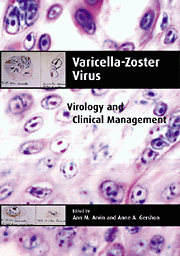Book contents
- Frontmatter
- Contents
- List of contributors
- Preface
- Introduction
- Part I History
- Part II Molecular Biology and Pathogenesis
- Part III Epidemiology and Clinical Manifestations
- Part IV Laboratory Diagnosis
- Part V Treatment and Prevention
- 18 Treatment of varicella
- 19 Treatment of herpes zoster
- 20 Management of postherpetic pain
- 21 Passive antibody prophylaxis
- 22 Development of the Oka vaccine
- 23 Primary immunization against varicella
- 24 Prevention of nosocomial transmission
- 25 Immunization against herpes zoster
- Index
- Plate section
25 - Immunization against herpes zoster
from Part V - Treatment and Prevention
Published online by Cambridge University Press: 02 March 2010
- Frontmatter
- Contents
- List of contributors
- Preface
- Introduction
- Part I History
- Part II Molecular Biology and Pathogenesis
- Part III Epidemiology and Clinical Manifestations
- Part IV Laboratory Diagnosis
- Part V Treatment and Prevention
- 18 Treatment of varicella
- 19 Treatment of herpes zoster
- 20 Management of postherpetic pain
- 21 Passive antibody prophylaxis
- 22 Development of the Oka vaccine
- 23 Primary immunization against varicella
- 24 Prevention of nosocomial transmission
- 25 Immunization against herpes zoster
- Index
- Plate section
Summary
Introduction
Reactivation resulting in infectious VZV in ganglia may occur sporadically throughout life, but the clinical importance of this phenomenon may be limited by VZV-specific immune responses. This might be accomplished either by a direct mechanism to inhibit reactivation or by rapid local clearing of reactivated virus, such that no signs or symptoms occur (subclinical reactivation). Infectious VZV has not been recovered from ganglia at autopsy, except in the special circumstance where the deceased had HZ at the time of death. There are no data on reactivation frequency as a function of age, but the concept of subclinical reactivation is supported by fluctuations in VZV-specific antibody and asymptomatic viremia observed during longitudinal studies of certain populations (Gershon et al., 1982; Ljungman et al., 1986; Wilson et al., 1992), and by case reports of neuropathic syndromes without cutaneous manifestations (zoster sine herpete) (Barrett et al., 1993; Gilden et al., 1994). Subclinical reactivation might be an important factor in maintaining VZV-specific immunity long after primary infection with varicella.
Role of VZV-specific immunity
There is very strong evidence that deficient VZV-specific immunity is closely correlated with the occurrence of clinically apparent reactivation.
- Type
- Chapter
- Information
- Varicella-Zoster VirusVirology and Clinical Management, pp. 500 - 519Publisher: Cambridge University PressPrint publication year: 2000
- 1
- Cited by

